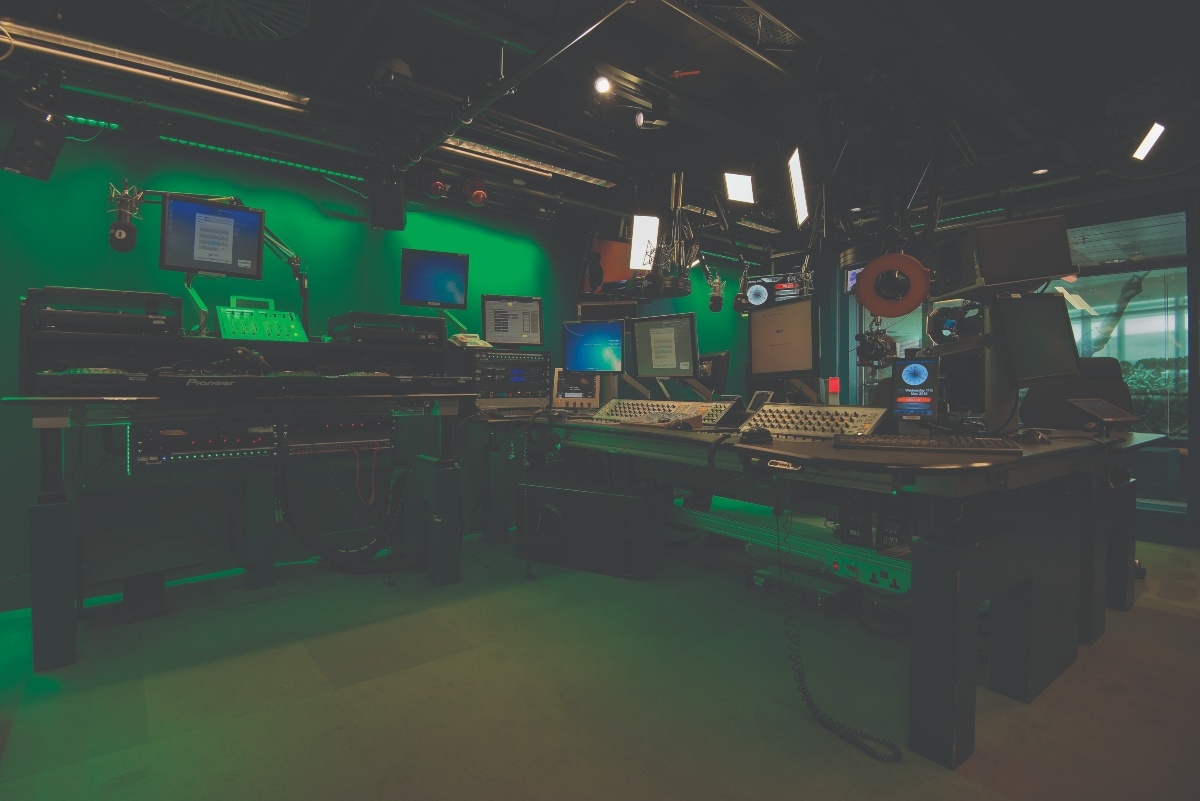
THURSDAY 07 NOVEMBER 2019
Radio 1, 1 Xtra, Asian Network & Live Lounge
Summary
Now successfully operating from the 8th floor of New Broadcasting House in London, Radio 1 is one of the most exciting and well-known users of IDS. In fact, Radio 1 could be seen as the most pivotal and instrumental users, shaping the evolution of IDS.
A purpose-built suite of six On-Air studios, news studios for Newsbeat and the famous ‘Live Lounge’ incorporates all the technology they could wish for. Including an IDS system with special features to make the most of the all-important online visualisation output, which incorporates lighting control and the ability to ingest material for display on large branding screens in each studio.
Although part of the overall 350-screen building-wide IDS implementation, the Radio 1 system shows how customised features can deliver a unique visual experience to complement the routine IDS functionality.
The brief
Radio 1 has its own style of operation and presentation, with a large number of its listeners following the programme on the web and via social media. Requests were made for additional IDS features to provide Presenters with intuitive local control of their environment and to enhance the visual experience for the audience. The flexibility of IDS allows non-technical users the freedom to control everything in the studio, a first for the broadcast environment.
One of the new studios with a typical IDS display, showing time and status, an IP-encoded camera and an IDS Presenter touchscreen unit.
These requests included:
- Remote control of the visualisation cameras in each studio, including a ‘privacy’ facility,
- Snoop Camera selection (used for interaction with another Presenter during changeovers),
- Easy selection of graphics, still or videos to be displayed on large ‘Branding’ screens,
- DMX control of lighting levels and colours,
- The ability to set all the clocks in a particular area to a different time of day (used when pre-recording a programme for later transmission).
The ability to use the touch screen as a control unit is a great feature. We can deploy branded content, videos or web channels to multiple screens, control cameras and lighting all from a single
desktop device.
-Tony Wood, Head of Radio One
The solution
Every Radio 1 Presenter has an IDS touchscreen as part of their standard equipment, so the first decision was to use this device to control all the new features required. We developed a user-friendly interface using new screen layouts that could be selected by a row of thumbnail tabs along the bottom of the main display. Each tab displays its own control layout to handle a specific set of functions and provide status feedback.
The camera tab handles everything to do with the fixed studio cameras. Their PTZ functions are controlled via IDS, allowing full independent control and a selection of preset configurations. One of the preset positions, selected by a single touch on the Presenter screen, points every camera vertically upward, an effective privacy setting which can also provide confidential feedback to those in the studio.
Two cameras in each studio are also designated for Snoop and CCTV. These are IP encoded onto the IDS network, becoming available on any screen on the system. The Presenter touchscreen has buttons to select any of the available Snoop pictures to display on preselected screens in the studio, using the images to check the presence of and interact with, Presenters or guests in other areas.
IDS Content Manager is a new feature developed specifically for the Radio 1 Branding application. Using a browser-based application in conjunction with an IDS Touchscreen allows the ingestion of a range of media (including HD) for display on any screen on the IDS system. The branding tab provides the Presenter with a choice of 10 automatically generated video thumbnails, which can be displayed in full on 60” branding screens or on other IDS displays around the network.
Each studio has three different lighting categories – Desk (LED strips running under the control desk furniture), Mood (colour washes on the walls) and Visualisation (for the cameras) – which can be controlled independently from a range of locations, including the Studios. The lighting tab on the IDS Touchscreen provides DMX controls and a range of preset options for each category via local IDS SQ-DMX controllers connected to the network.
Time displays are at the heart of IDS, and it is, therefore, relatively simple to provide a time offset to pre-defined groups of screens but more complex to provide the operator with a simple interface for the purpose, as required for time-shifted pre-recording. This was achieved by designing a new screen layout that controlled time, date and offset duration with a reset function in case the studio goes into the transmission. Alerts can be added to avoid a Studio accidentally operating in the wrong time zone.
Most of these new features were introduced before Radio 1 moved into their new Studios and have been adopted enthusiastically by the users. Incorporation of the control functions into the familiar touchscreen device has minimised the requirement for training and familiarisation, demonstrating that further functions could be introduced with minimum disruption and without requiring more cabling or desk space.


Contact us
For more information about Densitron or any of our products and services please contact one of our regional offices or contact@densitron.com